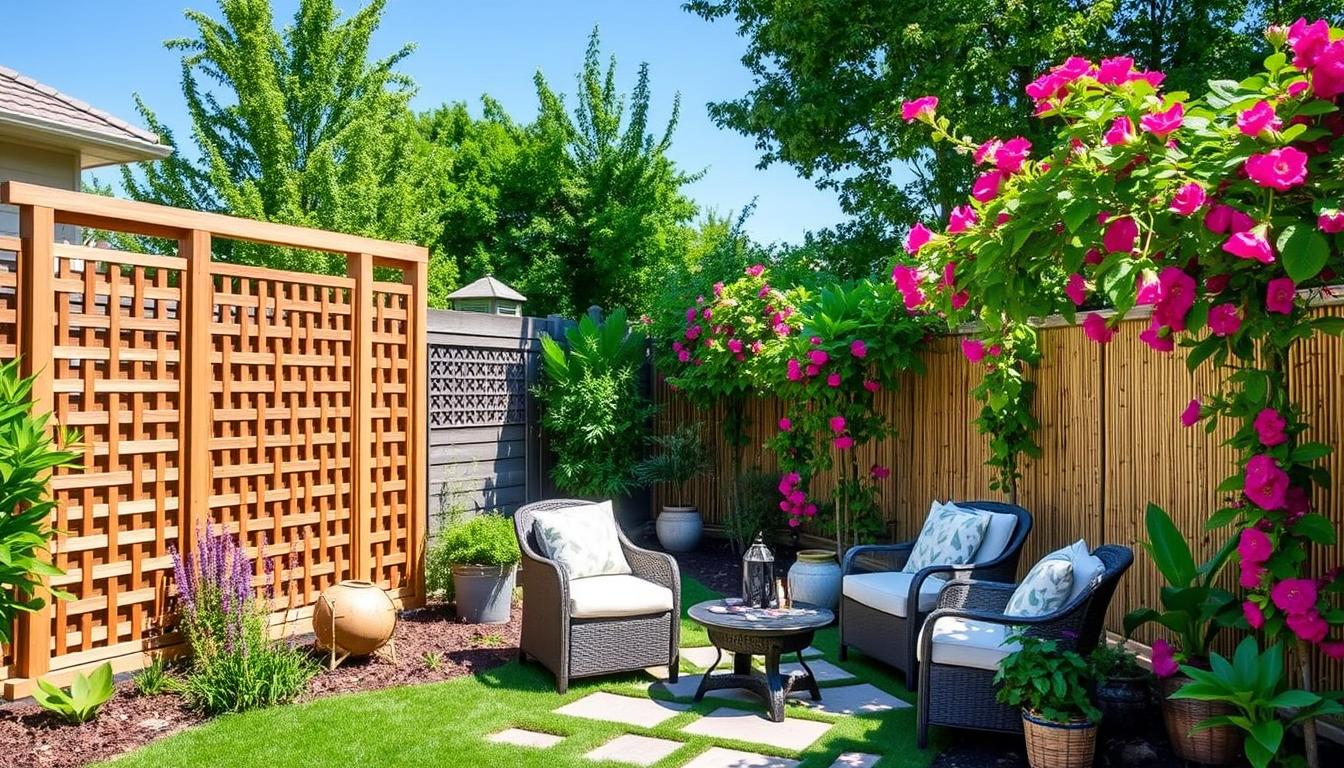Many homeowners prioritize creating a private outdoor space. DIY outdoor privacy screens provide various options for every yard and budget. They can block unwanted views or create a secluded oasis. With the right materials and creativity, you can enhance your yard privacy and expand your outdoor living area.
There are countless ways to build a private and comfortable outdoor area. From traditional wooden screens to modern metal designs, the possibilities are endless. Exploring DIY outdoor privacy screens allows you to find the perfect solution for your unique needs and style. You can create a private outdoor haven that reflects your personality and complements your home’s exterior.
DIY outdoor privacy screens offer benefits like increased yard privacy, improved outdoor living space, and enhanced curb appeal. By taking on a screen building project, you can add a personal touch to your outdoor space. This unique feature can make your home stand out from the rest.
Introduction to DIY Outdoor Privacy Screens
Key Takeaways
- DIY outdoor privacy screens offer a range of privacy options for every yard and budget
- Screen building can be a fun and rewarding project for homeowners
- Yard privacy can be enhanced with the right materials and a little creativity
- Customizable solutions are available for every yard and budget
- DIY outdoor privacy screens can increase outdoor living space and curb appeal
- Screen building projects can add a personal touch to your outdoor space
Understanding Outdoor Privacy Screens and Their Benefits
Outdoor privacy screens are a fantastic way to craft private areas in your yard. They enable you to unwind and enjoy the outdoors without interruptions. These screens serve as effective garden dividers, dividing your yard into distinct sections. This setup not only boosts your property’s value but also fosters a serene living space.
One of the key advantages of outdoor privacy screens is their capacity to shield against noise pollution and harsh weather. They are perfect for those seeking a tranquil outdoor retreat. Also, these screens act as a natural barrier, enhancing privacy and security by separating your yard from neighboring properties.
Creating Personal Outdoor Spaces
Outdoor privacy screens are ideal for setting up personal outdoor retreats. By encircling your patio or deck with screens, you can establish a secluded spot for dining, reading, or simply basking in the breeze. They also help demarcate different zones within your yard, such as a garden or play area.
Environmental Benefits of Privacy Screens
Outdoor privacy screens offer environmental advantages, like diminishing wind and noise pollution. They contribute to a calmer, more serene environment, beneficial for both you and the planet. Plus, screens crafted from eco-friendly materials, like bamboo or recycled wood, can significantly lower your carbon footprint.
| Benefits of Outdoor Privacy Screens | Description |
|---|---|
| Creates private spaces | Allows for relaxation and seclusion |
| Blocks out noise pollution | Creates a more peaceful environment |
| Provides a natural barrier | Separates your yard from neighboring properties |
Essential Materials for Building Privacy Screens
Choosing the right screen materials is key for effective yard privacy and longevity. The array of options, from wood and metal to vinyl and fabric, can be daunting. It’s important to weigh the pros and cons of each, including cost, upkeep, and appearance.
A well-built privacy screen can transform your outdoor area, offering both seclusion and peace. Key materials to ponder include:
- Frames: Constructed from wood, metal, or vinyl, frames are the backbone of your privacy screen.
- Panels: With choices like wood, metal, and fabric, panels allow for customization to meet your privacy and style needs.
- Hardware: Essential for assembly and stability, hardware includes screws, nails, and brackets.
Opting for the correct screen materials and considering durability, upkeep, and cost can lead to a stunning privacy screen. This will not only boost your yard privacy but also elevate your outdoor living experience.
Natural Privacy Screen Options
For those seeking a more natural and serene outdoor space, natural privacy screens are ideal. These options not only offer privacy but also enhance your garden’s elegance and sophistication. Garden dividers can demarcate different yard areas, creating private spaces ideal for relaxation or entertainment.
Living wall solutions are a popular choice for natural privacy screens. They can be crafted from various plants and materials, tailored to your needs and style. Bamboo screen designs, being eco-friendly, add a unique and exotic flair to your outdoor space. Screen building is a fun, creative endeavor, allowing you to showcase your personality and style.
Living Wall Solutions
Living walls bring greenery to your outdoor space while offering privacy. They feature a range of plants, including flowers, shrubs, and vines. Succulents, ferns, and ivy are among the most sought-after plants for living walls.
Bamboo Screen Designs
Bamboo screens are favored for their durability and eco-friendliness. They can be fashioned into various designs, from simple to complex. Bamboo screens can also be paired with wood or metal for a unique, customized look.
Climbing Plant Integration
Climbing plants enhance outdoor beauty while providing privacy. They can be trained to climb screens or trellises, showcasing lush foliage and flowers. Roses, clematis, and wisteria are among the most popular climbing plants.
| Privacy Screen Option | Benefits |
|---|---|
| Living Wall Solutions | Provides privacy, adds greenery to outdoor space, can be customized |
| Bamboo Screen Designs | Durable, sustainable, can be combined with other materials |
| Climbing Plant Integration | Provides natural beauty, can be trained to climb up screens or trellises |
Modern Privacy Screen Designs for Contemporary Homes
Homeowners have a variety of options for outdoor screens, including modern designs that boost yard privacy. Contemporary homes need sleek, sophisticated outdoor areas. The right screen materials can make this possible. Metal screens, glass panels, and wooden screens are popular choices, each offering a unique style and function.
Metal screens can introduce an industrial vibe to a yard. Glass panels offer a sense of openness and transparency. Wooden screens, by contrast, add a warm, natural feel to outdoor spaces. The choice of material depends on personal taste and desired aesthetic.
Modern privacy screen designs offer several benefits:
- Enhanced yard privacy
- Increased outdoor living space
- Improved aesthetic appeal
By selecting the right outdoor screens and materials, homeowners can craft a private, comfortable outdoor area. This space is ideal for relaxation and entertainment.
Budget-Friendly Privacy Screen Solutions
Creating a beautiful outdoor privacy screen doesn’t have to be expensive. In screen building, there are many affordable options. Consider using upcycled materials like old pallets or reclaimed wood for a unique and functional screen.
For those aiming to create private spaces in their yard, affordable materials like bamboo or fabric are great. These can be used to make various garden dividers that are both useful and attractive. Some cost-effective solutions include:
- Repurposing old fences or screens
- Using natural materials like plants or trees
- Creating a DIY screen with affordable materials
By being creative with materials and design, you can make a stunning privacy screen without overspending. Remember to think outside the box and enjoy the screen building process.
With a bit of imagination and some budget-friendly options, you can craft a beautiful and practical privacy screen. It will enhance your outdoor private spaces and garden dividers.
| Material | Cost | Effectiveness |
|---|---|---|
| Bamboo | Affordable | High |
| Fabric | Low | Medium |
| Reclaimed Wood | Medium | High |
Tools and Equipment Needed for Screen Construction
Building outdoor screens for yard privacy requires the right tools and equipment. The choice of screen materials influences the tools needed. Yet, some basics apply to most outdoor screens.
To ensure a successful DIY project, consider the following necessary tools and equipment:
- Power tools, such as drills and saws, for cutting and assembling screen materials
- Hand tools, like hammers and tape measures, for measuring and securing outdoor screens
- Safety gear, including gloves and safety glasses, to protect yourself while working with power tools and screen materials
Having these tools and equipment ready will prepare you to construct your outdoor screens. This way, you can enjoy the benefits of yard privacy.
Always follow safety guidelines and manufacturer instructions when using power tools and equipment. If unsure about any part of the screen construction process, don’t hesitate to seek help.
| Tool | Description |
|---|---|
| Drill | Used for drilling holes in screen materials |
| Saw | Used for cutting screen materials to size |
| Hammer | Used for securing outdoor screens in place |
Step-by-Step Privacy Screen Installation Guide
Creating private spaces in your yard is crucial, and a well-designed privacy screen can be a game-changer. With your materials and tools ready, it’s time to begin constructing your outdoor privacy screen. This journey involves several essential steps, from foundation preparation to the final touches.
The initial step in screen building is foundation preparation. This means clearing the area and ensuring a level surface. Then, assemble the screen by screwing or nailing the frames together. Lastly, add decorative elements or garden dividers to finish your private space.
Here are some key considerations for the installation process:
- Choose materials suitable for your climate and desired privacy level
- Consider the style and design of your garden dividers and how they’ll complement your yard’s aesthetic
- Ensure compliance with local building codes and regulations when installing your privacy screen
By adhering to these steps and considering these factors, you can craft a beautiful and functional privacy screen. It will enhance your outdoor living space and provide the private areas you seek.
| Material | Climate | Privacy Level |
|---|---|---|
| Wood | Mild | High |
| Metal | Harsh | Medium |
| Bamboo | Tropical | Low |
Maintenance and Care for Outdoor Privacy Screens
To ensure your outdoor privacy screens last, regular maintenance is crucial. This includes cleaning, repairing, and protecting them from the elements. By following these tips, you can extend your screens’ life and keep them in top condition.
Outdoor screens, made from durable materials, are a great solution for yard privacy. Yet, they need regular care to withstand the weather. Here are some essential tips:
- Regularly clean the screens to remove dirt and debris
- Inspect the screens for damage and repair them as needed
- Apply a protective coating to the screens to shield them from the elements
By adhering to these guidelines, you can maintain your outdoor privacy screens effectively. This ensures they remain functional and visually appealing for years. Choose materials that are both durable and weather-resistant for the best results.
Regular maintenance is key to extending the life of your outdoor privacy screens and keeping them looking their best.
With the right care and maintenance, your outdoor privacy screens can enhance your yard’s privacy and beauty. They add a touch of elegance to your outdoor space.
| Screen Material | Maintenance Requirement |
|---|---|
| Wood | Regular staining and sealing |
| Metal | Regular cleaning and rust-proofing |
| Plastic | Regular cleaning and replacement of damaged panels |
Creative Design Ideas for Small Yards
Even with limited space, it’s possible to create a stunning outdoor area. This area can provide private spaces and act as beautiful garden dividers. In small yards, every inch is crucial. That’s why space-saving solutions are essential. Vertical screens or folding screens are great options. They can be easily installed and don’t take up too much space.
Screen building can be a fun and creative process, even in small yards. By using multi-functional screens, you can create a private and cozy atmosphere. You can also add a decorative element to your outdoor space. Ideas include screens with built-in planters or screens that double as a trellis for climbing plants.
- Using garden dividers to separate different areas of the yard and create a sense of intimacy
- Incorporating screen building materials that are durable and low-maintenance
- Adding decorative elements, such as lighting or artwork, to enhance the ambiance of the outdoor space
By thinking outside the box and getting creative with your screen building and garden dividers, you can transform your small yard. It can become a private and beautiful oasis.
Weather-Resistant Privacy Screen Options
Outdoor screens are crucial for maintaining yard privacy. Homeowners seek materials that can endure harsh weather. Weather-resistant options ensure durability and longevity, even in extreme conditions.
All-Season Materials
Popular choices include waterproof fabrics, rust-resistant metals, and durable plastics. These materials handle extreme temperatures, heavy rainfall, and intense sunlight. For instance, a waterproof fabric screen offers privacy and withstands heavy rainfall and snow.
Weatherproofing Techniques
Weatherproofing techniques enhance outdoor screen longevity. Applying a waterproof coating, using rust-resistant frames, or installing drainage systems are effective. Combining these with weather-resistant materials creates a durable, long-lasting privacy screen.
- Waterproof fabric screens
- Rust-resistant metal screens
- Durable plastic screens
Choosing the right materials and techniques ensures a private, comfortable outdoor space. Enjoy it all year round.
| Screen Material | Weather Resistance | Durability |
|---|---|---|
| Waterproof Fabric | Excellent | High |
| Rust-Resistant Metal | Good | Medium |
| Durable Plastic | Fair | Low |
Local Regulations and Building Codes for Privacy Screens
Before embarking on your screen building project, it’s crucial to verify compliance with local regulations and building codes. This step is vital to sidestep any potential issues or fines. When crafting private spaces, it’s essential to adhere to the rules and guidelines set by your local government.
Considerations include height restrictions, material requirements, and permit necessities. For example, garden dividers might face specific regulations, such as maximum height or material type. Understanding these regulations is key to a smooth and successful installation.
To ensure compliance, you can:
- Check your local government website for building codes and regulations
- Consult a professional contractor or builder familiar with local regulations
- Obtain necessary permits before commencing your project
By grasping and adhering to local regulations and building codes, you can create a stunning and functional outdoor space. This space will meet your needs and enhance your private areas.
Conclusion: Creating Your Perfect Outdoor Haven with Privacy Screens
Outdoor privacy screens are a great way to turn your yard into a peaceful retreat. They help create a cozy spot, boost your property’s value, or let you enjoy the outdoors without disturbance. These solutions are essential for achieving your ideal outdoor haven.
There’s a wide range of options, from natural screen materials like living walls and bamboo to modern, durable designs. By using the tips and guidelines from this article, you can create a privacy screen that matches your style and needs perfectly.
Don’t delay in planning your dream outdoor space. With a beautiful outdoor privacy screen, you can turn your yard into a serene sanctuary. Explore the possibilities and make your backyard retreat a reality.


